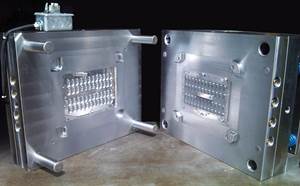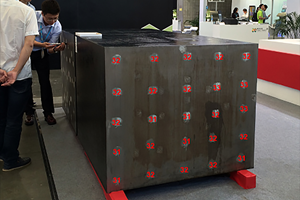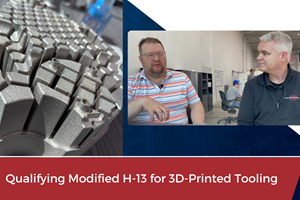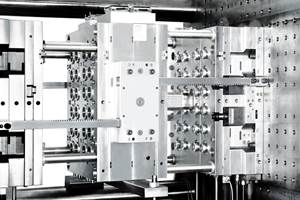Steel Choice Matters for Corrosion Resistance
A free-machining stainless steel faces the extremely corrosive injection molding environment head on, improving machinability and stability.
Tool steel resists condensation, and waterline corrosion, which is especially important as the use of corrosive materials like fire-retardant additives, PVC and aminoplast increases. However, with every positive there is typically a negative. For example, corrosion-resistant plastic injection mold steels require additional machining time that increases wear, and more complex mold bases cause 60 percent of the steel to become chips.
To address these challenges, steel suppliers continue to develop specialty steels to combat the extremely corrosive injection molding environment while improving steel’s machinability and stability. For example, a free-machining stainless steel that offers a balance between machinability and corrosion resistance by combining a special chemical composition with a special heat-treatment process.
Low-carbon content and alloying elements such as chromium, manganese, and other additions play an important role in this free-machining stainless steel. The alloying elements are added during production and combine to yield optimal hardness, machinability and corrosion resistance (see Table 1).
| C | Si | Mn | S | Cr | Additions |
|---|---|---|---|---|---|
| 0.05 | 0.40 | 1.30 | 0.15 | 12.50 | + |
Table 1. Chemical composition in weight-%.
The heat treatment process further refines the steel at the final production process. The material is heated to a temperature of 1,475°F under controlled conditions and quenched in water or a polymer, which promotes the characteristic of a homogenous microstructure yielding material that is consistent throughout and extremely stable.
To assess corrosion resistance and determine the appropriate testing method, the mold builder must understand the type of corrosion that may occur. The corrosion behavior is a system property. The corresponding tests only reveal the classification of the steels in the same testing structure. Several tests were conducted on this free-machining stainless steel in laboratory conditions with media containing chloride, condensation and in slightly acidic conditions. A sulfur-alloyed steel was tested for comparison. The results indicated that the free-machining steel and the sulfur-alloyed steel are nearly identical in corrosion resistance. The free-machining steel also offers an increase in cost-effectiveness and productivity by decreasing machining cost and lead times (see Figure 1).

Figure 1. Comparing machinability in % (sulfur-alloyed steel 325 HB, free-machining stainless steel 370 HB).
To optimize machining efficiencies and lead times, refer to the process recommendations in Table 2.

Table 2. Machining values for free-machining stainless steel (hardness 290 - 332 HB)
Mold material choice is one of the key variables influencing plastic part production profitability, so it may be time to consider the machinability, dimensional stability and weldability benefits of a free-machining stainless steel, which can also enhance mold performance with its toughness, minimal residual stresses, and good corrosion resistance.
Related Content
Three Considerations for Mold Steel Selection
Although a big challenge is selecting the right steel for the right job, steel selection has never been better in regards to quality, price and delivery speed. Here is a simple checklist when selecting your next mold steel.
Read MorePre-Hardened Mold Steel Material Increases Through-Hardened Ability
Finkl Steel’s patented pre-hardened mold steel grade MD Xtra material achieves high impact strength, enhanced thermal conductivity and is an exceptional solution for deep impression applications.
Read MoreVIDEO: Qualifying Modified H-13 for 3D-Printed Tooling
Next Chapter Manufacturing and International Mold Steel discuss their partnership to qualify a modified H-13 for tooling applications.
Read MoreHow to Lower Cycle Times With the Right Tool Steel
Combining excellent mechanical properties, high wear resistance and high thermal conductivity in a specialty tool steel yields cycle time reduction.
Read MoreRead Next
Are You a Moldmaker Considering 3D Printing? Consider the 3D Printing Workshop at NPE2024
Presentations will cover 3D printing for mold tooling, material innovation, product development, bridge production and full-scale, high-volume additive manufacturing.
Read MoreReasons to Use Fiber Lasers for Mold Cleaning
Fiber lasers offer a simplicity, speed, control and portability, minimizing mold cleaning risks.
Read MoreHow to Use Continuing Education to Remain Competitive in Moldmaking
Continued training helps moldmakers make tooling decisions and properly use the latest cutting tool to efficiently machine high-quality molds.
Read More

























